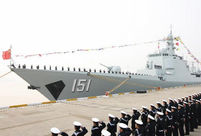 Harbin Int'l Ice and Snow Festival opens
Harbin Int'l Ice and Snow Festival opens 'Jin' named the word of the year by cross-strait netizens
'Jin' named the word of the year by cross-strait netizens Chinese scientific expedition goes to build new Antarctica station
Chinese scientific expedition goes to build new Antarctica station
 Chinese naval escort fleet conducts replenishment in Indian Ocean
Chinese naval escort fleet conducts replenishment in Indian Ocean 17th joint patrol of Mekong River to start
17th joint patrol of Mekong River to start China's moon rover, lander photograph each other
China's moon rover, lander photograph each other Teaming up against polluters
Teaming up against polluters
Construct a "two horizontal three vertical" urbanization strategy
The core of urbanization is the "urbanization of people", which is generally reflected in a decline in the rural population and a growth in the urban population. The future lies in medium and small cities.
The National Plan of Main Functional Areas (abbreviated as NPoMFA, published by State Council, 2010) has made arrangements for an overall blueprint of urbanization, proposing a "two horizontal three vertical" strategic pattern of urbanization.
The strategy seeks to expand economic growth and activity from east to west, and from south to north by taking the Land Bridge (Eurasian Transcontinental Railroad) route and the route along Yangtze River as two horizontal axes, and the east coast, the Beijing-Harbin-Beijing-Guangzhou route, and the Baotou-Kunming route as the three vertical axes. A number of cities along the axes will be designated as centers for an urbanization strategy framework managing other constituent urbanized areas and cities.
Experts claim that uncontrolled development of cities would lead to an unmanageable urban sprawl, while the concept of urban agglomeration is to form a collection of medium and small cities that have regional strengths and complement their existing differences. In other words, these agglomerations can also be considered as "organic megacities".
Xu Fengxian, senior researcher of the Institute of Economics, Chinese Academy of Social Sciences, says that the "two horizontal three vertical" urbanization strategy will promote the formation and development of urban agglomerations, which will accelerate the development of the medium and small cities affected.

 Chinese Consulate General in S.F. burned for arson attack
Chinese Consulate General in S.F. burned for arson attack Roar of J-15 fighter is melody for operator on the Liaoning
Roar of J-15 fighter is melody for operator on the Liaoning A 90-year-old forester's four decades
A 90-year-old forester's four decades Most touching moments in 2013
Most touching moments in 2013 2013: Joys and sorrows of world politicians
2013: Joys and sorrows of world politicians Missile destroyer Zhengzhou commissioned to Chinese navy
Missile destroyer Zhengzhou commissioned to Chinese navy China is technically ready to explore Mars
China is technically ready to explore Mars Photo story: Life changed by mobile technology
Photo story: Life changed by mobile technology Bullet train attendants' Christmas Eve
Bullet train attendants' Christmas Eve Cradle of high-speed train CRH380A
Cradle of high-speed train CRH380A  'Red Army' division conducts winter training in N China
'Red Army' division conducts winter training in N China  Classic scenes come to life
Classic scenes come to life Harbin Int'l Ice and Snow Festival opens
Harbin Int'l Ice and Snow Festival opens  Cindy attends commercial event with her parents
Cindy attends commercial event with her parents Get to know China's national pole dancing team
Get to know China's national pole dancing teamDay|Week|Month